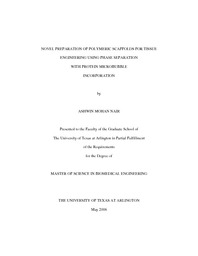
ATTENTION: The works hosted here are being migrated to a new repository that will consolidate resources, improve discoverability, and better show UTA's research impact on the global community. We will update authors as the migration progresses. Please see MavMatrix for more information.
Show simple item record
| dc.contributor.author | Nair, Ashwin | en_US |
| dc.date.accessioned | 2008-08-08T02:31:00Z | |
| dc.date.available | 2008-08-08T02:31:00Z | |
| dc.date.issued | 2008-08-08T02:31:00Z | |
| dc.date.submitted | April 2006 | en_US |
| dc.identifier.other | DISS-1236 | en_US |
| dc.identifier.uri | http://hdl.handle.net/10106/892 | |
| dc.description.abstract | Poly (lactic-co-glycolic acid) (PLGA) has been extensively used as a biodegradable and porous tissue scaffold due to their biocompatibility and degradability. Several techniques have been developed for the fabrication of polymeric scaffolds but they all have some limitation or the other which has in turn hampered the growth of cells seeded on them. Salt leached scaffolds have good porosity and large pores but poor mechanical strength and the problem of residual salt even after leaching. Similarly gas foaming scaffolds have shown large pores but poor interconnection with residual ammonium salts. Other methods like thermally induced phase separation and
fiber bonding do not involve the use of porogens and have yielded porous scaffolds although with small pores. To overcome these common problems, in this study, the use of protein microbubbles as a porogen and drug/protein carrier to produce polymeric scaffolds with good porosity was conceptualized. PLGA scaffolds were prepared by thermally induced phase separation with the incorporation of protein microbubbles. Two types of protein microbubbles, BSA and gelatin, were evaluated for their suitability as a porogen. The microbubbles which were incorporated in to the scaffolds at the time of fabrication were analyzed for their size and the scaffolds were characterized by SEM analysis and histological techniques. SEM revealed the synthesis of open pores measuring around 100 to 120 µm regardless of the type of protein used for synthesizing the microbubbles.
This novel technique provides two distinct advantages. First, microbubbles are made of biological materials which have no toxicity. Second, apart from having produced scaffolds with larger pores compared to conventional methods, our novel scaffold also has the potential to function as a delivery mechanism for chemokines and drugs in to the polymeric matrix. The scaffold can be degraded in a controlled manner to release the desired molecules to effect the desired cellular response. | en_US |
| dc.description.sponsorship | Tang, Liping | en_US |
| dc.language.iso | EN | en_US |
| dc.publisher | Biomedical Engineering | en_US |
| dc.title | Novel Preparation Of Polymeric Scaffolds For Tissue Engineering Using Phase Separation With Protein Microbubble Incorporation | en_US |
| dc.type | M.S. | en_US |
| dc.contributor.committeeChair | Tang, Liping | en_US |
| dc.degree.department | Biomedical Engineering | en_US |
| dc.degree.discipline | Biomedical Engineering | en_US |
| dc.degree.grantor | University of Texas at Arlington | en_US |
| dc.degree.level | masters | en_US |
| dc.degree.name | M.S. | en_US |
| dc.identifier.externalLink | https://www.uta.edu/ra/real/editprofile.php?onlyview=1&pid=58 | |
| dc.identifier.externalLinkDescription | Link to Research Profiles | |
Files in this item
- Name:
- umi-uta-1236.pdf
- Size:
- 8.683Mb
- Format:
- PDF
This item appears in the following Collection(s)
Show simple item record


